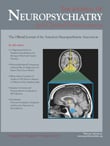Pisa Syndrome During Amisulpride Treatment
To the Editor: Pisa syndrome, a movement disorder characterized by tonic, sustained lateral flexion with slight posterior rotation of the trunk, was first reported in 1972. 1 It appeared mainly subsequent to typical antipsychotics. Rare cases have been recently reported with atypical antipsychotics, cholinesterase inhibitors, and valproic acid. 2 Amisulpride, an atypical antipsychotic, induced fewer movement disorders. To our knowledge, there have been no reports of amisulpride-induced Pisa syndrome in the literature. This report presents a case of amisulpride induced Pisa syndrome.
Case Report
A 26-year-old man was diagnosed with schizophrenia 5 years ago without history of major operations, neurological disorders, or drug abuse. Initial laboratory studies, including thyroid function test and serum electrolyte, were within normal ranges. He had been treated with risperidone, 6 mg/day, for the previous 6 months. He was admitted for disorganized speech, auditory hallucination, and persecutory delusions. On the first day, risperidone, 6 mg/day, was prescribed. The risperidone was tapered and stopped within 2 days for inadequate control of symptoms, whereas amisulpride, 800 mg/day, and valproic acid, 1,000 mg/day, were added on the second day. Two weeks later, he was observed walking with a tilt toward the left. Valproic acid levels were normal, and a physical examination revealed sustained tonic flexion of the trunk to the left side with slight backward rotation. No neurological deficits or mental status changes were noted. The differential diagnosis of catatonic presentation was ruled out. Trihexyphenidyl, 15 mg/day, was prescribed for acute dystonia. Diphenylhydramine, 100 mg/day, was also prescribed, but the symptoms did not improve after 1 week. Pisa syndrome was highly suspected, and amisulpride was tapered and stopped. Quetiapine was cross titrated to 800 mg/day to control his psychotic symptoms. The symptoms gradually resolved within 12 days.
Discussion
The incidence rates of Pisa syndrome were poorly established and seemed to be low. In 1991, a study by Yassa et al. 3 reported a rate of 8.3%. Similarly, a German study showed a lower rate of 0.037% in 2000. 4 It occurred mostly during the first month of treatment and responded to the discontinuation of antipsychotics. 5 In our case, it developed after 2 weeks of amisulpride administration and resolved with dose reduction.
Risk factors were female gender, old age, organic brain disorder, and typical antipsychotics. 4 Our patient was a young man without organic brain disorder. The clinical characteristics suggested that the underlying pathophysiology might be drug-related.
The pathophysiology was controversial. The common hypothesis was dopaminergic-cholinergic imbalance, an excess of cholinergic neurotransmission, and a decrease of dopaminergic neurotransmission. 6 Different antipsychotics had varying degrees of cholinergic and dopamine antagonistic effects. In our case, tapering off risperidone and switching to amisulpride resulted in this imbalance. Thus, switching of antipsychotics should be performed gradually, especially when the former antipsychotic has potent effects. The most effective treatment was either reduction or discontinuation of current medications. Delayed treatment may harm the rehabilitation of patients. Early detection of these symptoms would improve the patient’s quality of life even more.
1. Ekbom K, Lindholm H, Ljungberg L: New dystonic syndrome associated with butyrophenone therapy. Z Neurol 1972; 202:94–103Google Scholar
2. Yohanan M, Aulakh J, Joanne W, et al: Pisa syndrome in a patient in a wheelchair taking valproic acid. Am J Psychiatry 2006; 163:325–326Google Scholar
3. Yassa R, Nastase C, Cvejic J, et al: The Pisa syndrome (or pleurothotonus): prevalence in a psychogeriatric population. Biol Psychiatry 1991; 29:942–945Google Scholar
4. Steubner S, Padberg F, Grohmann R, et al: Pisa syndrome (pleurothotonus): report of a multicenter drug safety surveillance project. J Clin Psychiatry 2000; 61:569–574Google Scholar
5. Duggal HS, Sivamony S, Umapathy C: Pisa syndrome and atypical antipsychotics. Am J Psychiatry 2004; 161:373Google Scholar
6. Gambarin M, Antonini A, Moretto G, et al: Pisa syndrome without neuroleptic exposure in a patient with Parkinson’s disease: case report. Mov Disord 2006; 21:270–273Google Scholar



